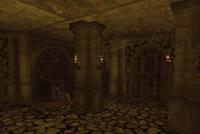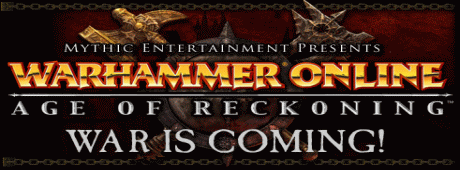|
|
|
Main News Forums Games Games Database Top 100 Release List Support Files Features Reviews Previews Interviews Editorials Diaries Misc Download Gallery Music Screenshots Videos Miscellaneous Staff Members Privacy Statement |
Warhammer Online: The Detailed Death of a MMORPG
You think you are a hardcore gamer. Define hardcore? Do you spend hours at your games? Do you memorize hoards of useless facts in order to give you a competitive advantage? Do you hand paint tiny metal miniatures numbering in thousands while meticulously gluing synthetic moss to a landscape built of plywood and architectural supplies that completely dominate your entire garage? Warhammer junkies do. And unless you are willing to invest in thousands of dollars in cast iron miniatures and hand paint your personal micro-army with the single hair pulled from a paintbrush, then you might want to refine your definition of hardcore. Warhammer aficionados reach the extreme of gaming. Games Workshop refined the ancient art of miniature war gamming into a multi-million dollar enterprise reaching beyond its humble 1981 roots in London England to become the multinational well-respected Warhammer property encompassing the war gamming, role-playing and now video game arenas. Games Workshop's Warhammer and Sci-Fi Warhammer 40K spin-off remain well respected due largely to the rich complex world and rule system they present. Relic Entertainment's digital adaptation of Warhammer 40K inspired many reviewers at this year's E3 expo. So it is now surprise that both fans and game industry watchers kept an eye on the Warhammer Online, the MMORPG similar to the their less popular pen and paper RPG adaptation, Warhammer Fantasy Role Play now owned and published by Hogshead publishing. However, the small understated booth at E-3 in 2003 was a surprise. Climax kept its small three-screen booth in an innocuous corner of the convention. At the time, the ink on the contract with distributor Sega only just dried; however, Climax already invested 20 months worth of programming building the game from the ground up. They took their adaptation of the Warhammer RPG seriously. How many MMORPG's attempt to incorporate a full blown weather system that affects combat? At the time, Climax demonstrated a base level presentation to give a glimpse of the world they attempted to create. The models only exhibited single source and ambient lighting making the models look something like a Ray Harryhausen Claymation model. An article in Game Developer magazine by Iain Chantlay on graphics programming techniques[*] showed that the development group progressed took the job seriously. Climax achieved an impressive level of engineering by showing off their anti-footslide technique of model time compression. By warping the animation's play time to the moving landscape, they managed to eliminate the annoying problem in graphics animation of models that move like Michael Jackson moonwalking on a conveyor belt. Most games still exhibit footslide, just take a look at any off the rack first person shooter. Does eradication of foodslide matter to game play? Probably not, but the level of technological achievement in a multiplayer online game remained impressive if not obsessive. Climax coded Warhammer Online mostly from the ground up using 3d Studio Max for design purposes only and tapping speed tree for outdoor tree occlusion in order to speed up the game performance. It was no wonder that Climax technical director Roccio Loscalzo described working on Warhammer as "the greatest fun but the hardest thing I have ever done." Sure, That's Exactly What It Looks Like (I Guess)! One of the challenges facing the team turned out to be the rather detailed 27 year old IP of Warhammer. Everyone knew what the cornucopia of creatures that comprise the world looked like from the highly detailed drawing and miniatures on the market. However, the question remained "How does a skaven move?" or "How do any of the countless creatures move?" And sure, copious detailed drawings existed of battle ready troops, but what does a baker in the Warhammer World look like? "We would get people saying ‘that's exactly what a But by E3 2004, the WO alliance showed signs of distress. The energy from the previous year looked drained away and the demo no longer resided on the show floor as it did the previous year. Also, a year's passing did not yield a lot of progress in demo quality. When asked about the reason for the slowdown, the Climax team mentioned "problems with the art pipeline." Essentially, the Climax team and the Games Workshop team fought over the graphical look of WO. Games Workshop presented beautiful gothic pencils complete with angst inspiring compositions. Looking at the complexity of those sketches, Games Workshop's demands seem strenuous considering the scope of the project. The press department assured that the alliance fixed the pipeline. However, the graphic look, despite the website pictures didn't quite live up to the hype. Compared to the graphical robustness of Van Helsing, a game set in a similar setting, Warhammer Online lacked the eye popping graphics necessary to hold the long term MMORPG player. The push to repulse inspired great looking monsters, but also created unattractive avatars. Since game play is about immersion, an avatar should look like an ideal version of the player, something that both teams seemed not to understand. When looking at the 2004 demo, the lack of multi-source lighting, an aspect mentioned in talks with Climax in 2003, signaled the problems with the development. They were slipping behind. The team themselves admitted that perhaps the project was originally overambitious. They scaled back some of the features mentioned in the previous year's press release. But close to a year's loss and an uncertain launch date heralded the title's demise. The numbers came back on what it would take to launch the title, $30 million US to finish the title and provide for backend servers and support. The number thrown out represented a desire to end the project. Fans will be sorry to see the title go, but should note that the Warhammer pen-and-paper RPG never did well in the marketplace. Game's workshop's strongest elements are the two wargame titles, one which is slated to publish within the next year. In truth, the game was not living up to what gamers would expect from an MMORPG and will more likely not miss the title in the long run. -------------------------------------------------------------------------------- [*] Chanlay, Iain " Taming Vertex Data: Using C++ Templates," Game Developer Magazine, CMP United Business Media, October 2003, pp 34-41 |
|||
|
All original content of this site is copyrighted by RPGWatch. Copying or reproducing of any part of this site is strictly prohibited. Taking anything from this site without authorisation will be considered stealing and we'll be forced to visit you and jump on your legs until you give it back. |
||





